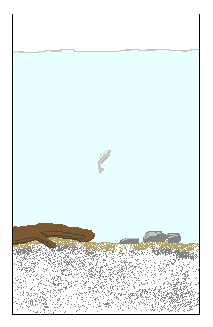
Even a small mountain stream provides an astonishing number of different places for animals to live, or habitats. The casual visitor would not see more than water and rocks, yet the stream is filled with unseen creatures. Where do they all live?
Rocks provide several different habitats. There is the side that faces upriver: animals that are very good at clinging to rock will do well here. The side that faces downriver provides a certain degree of shelter from current, while still allowing an animal to hunt for food. The top of a rock, if it is contacting air in some places, will be a good place for animals that can't breathe underwater and need to surface now and then. Underneath the rock is a very popular place for animals who don't want to be eaten!
Microhabitat describes very local habitats like this, the small spaces that are chosen by each organism. Some creatures make their own microhabitats. Many (but not all) caddisflies build cases about themselves. Other animals dig holes in banks or in the mud on the bottom.
Fallen logs and branches (Large Woody Debris, or LWD), provide a place for some animals to burrow into and surfaces for others to attach themselves, as they might to a rock. They also create areas where small detritus such as leaf litter can pile up underwater. These piles of leaf litter are excellent shelter for many creatures, including hellgrammites (large, fiercely predaceous larvae of dobsonflies).
Besides providing microhabitats, fallen logs, branches, rootwads, and even rocks perform the valuable service of clogging streams. A well-obstructed stream is a healthy one. Streams clogged with natural debris form countless small pools, waterfalls, and other features that provide habitat, as well as hiding places for young fish.
There is other debris, leaf litter, and algae floating downstream, and animals cling to this or burrow into it, as well as eat it. Parasites make their host their habitat.
Often the only way to determine what microhabitat an animal uses is by either catching it in the habitat (using intensive electroshocking while making many observations and measurements) or by observing it in its habitat. This may be done by looking beneath the water through a pane of glass, setting cameras in the water, or snorkeling.

|
Surface
Water-Column Benthic Zone Hyporheic Zone |
You can see the different parts of a river by running your mouse over the pictures or labels on this page. Clicking on what you see will give you a pop-up window that tells you what lives there. Remember to close the pop-up window before you click on anything else. Otherwise (depending on what browser you are using), it will end up behind your page!

|

|
Cascade |
The terms shown above in the pictures are habitat classifications. Others include side channel, which is a small area where water has left and then returned to the river, running parallel to the river, backwater, much like a side channel but with the upstream end blocked off, creating stagnant water, embayment, which you might say is almost like a backwater, but not nearly so extreme or cut off, and in which the water is still actively running, and plunge, an area where water runs off a submerged obstacle and creates a deep, though flowing, area on the other side of it (and still technically part of the run).

|
| Cascade | Falls | Pool | Embayment | Run | Plunge | Riffle | Backwater |
Finally, a stream's ecosystem includes the area immediately around the stream--the damp banks and vegetation on both sides, the trees that hang over it, the air above it. And it includes the stream's entire watershed as well.
 Read Following a River Wherever it Goes: Beneath the Surface of Mountain Streams
Read Following a River Wherever it Goes: Beneath the Surface of Mountain Streams
 An in-depth examination may be found in Aquifers and hyporheic zones: Towards an ecological understanding
of groundwater
An in-depth examination may be found in Aquifers and hyporheic zones: Towards an ecological understanding
of groundwater
![]() To learn more about habitats, check out the reading list, where you will find some excellent references listed. (You will be able to order them from here, too).
To learn more about habitats, check out the reading list, where you will find some excellent references listed. (You will be able to order them from here, too).

| Site Search |